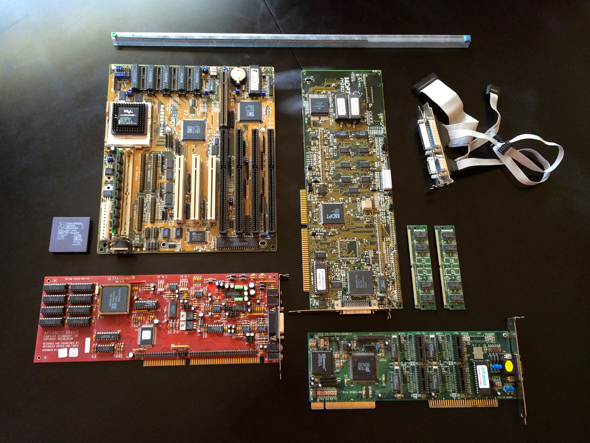A few weeks back I wrote a post detailing my desire to build a 486-class DOS box. In the time since then, I’ve been actively digging parts out of my storage shelves and scanning eBay for the remaining, needed items.
I though I’d post a list of parts for this build, and where I am on each right now, given that things are getting pretty close to go time.
In hand:
- ASUS PVI-486SP3 motherboard
- AMD 5×86 133 CPU
- Tseng ET4000/W32p-based VLB video card
- V53C8256HP45 DRAM DIPs to double video card’s RAM (to 2MB)
- Gravis Ultrasound (Classic, ISA) w/ 1MB RAM
- DPT PM2021 SCSI controller (ISA)
- Logitech MouseMan 3-button serial mouse
- MS-DOS 6.22 install floppies
- Windows 98SE install CD
Ordered, on the way:
- AT-class desktop case with 3.5-inch floppy drive and PSU
- 3COM EtherLink III 10base-T ethernet card (ISA)
- 2x 16MB 60ns Fast Page Mode, non-parity DRAM SIMMs
- Nine CY7C199CN-15PXC 15ns, 256Kbit, parallel SRAM DIPs (to provide 256KB motherboard L2 cache)
- 486 heatsink / fan
- Arctic Silver 5 thermal compound
Yet to procure:
- SCSI CD-ROM drive
- SCSI hard drive
- IDE 5.25-inch bay combo flash RAM card reader
Now, as I mentioned in my earlier post, I am basically trying to build a replica of the PC I had in 1996. It started out as a 486DX2 66 in 1994 and was upgraded over the next two years. Because of my rather particular hardware requirements, this project has taken on a cost well beyond what I had initially envisioned. I think I’ve spent close to $500 so far, though the original 486DX2 66 I procured to run NeXTSTEP for Intel in 1994 cost a full $4,500 (= student loan).
The purpose of this machine is to have an (ideal) vehicle upon which to enjoy mid-90’s era DOS demoscene productions, MOD/S3M/XM audio tracks, and games. The system should be capable of running Windows 98SE quite well, but that’s really a secondary consideration.
I shall post another update in a week or so — that, perhaps, being a full build video. Time (and shipping progress) will tell.


Pingback: 486 DOS PC rebuild. | StiGGy's Blog
Sounds like a fun project – will be fun to see how it comes out.
Would be neat to see the Intel version of Next Step running on it..
Derek
Hi, do you think the Gravis Ultrasound is better than the SoundBlaster 16/AWE32? I never had an Ultrasound, so I can’t really tell… plus it was almost impossible to find one of those here in Brazil.
Nice project of yours…
Tiago, the SoundBlaster AWE32 (and AWE64) are technically superior to the GUS. They have beefier audio hardware and, I believe, the capability of more onboard memory, and they interpolate audio using cubic spline interpolation, which is superior to the GUS’ approach of linear interpolation. However, the AWE32/64 never saw the demoscene adoption that the GUS enjoyed, and so the GUS was the best card to have if the demoscene was a primary interest of the user, as it was/is to me.
Gravis contributed notable $$ and resources to euro demo parties in the early ’90s. They were loved by the scene coders of the day.
Tiago, …also, both the GUS and the AWE32/64 took very little CPU resources for quality playback. The SoundBlaster 16 and other traditional sound cards took notable CPU resources to mix the sound. This was a major reason why the GUS, first on the scene of these wavetable cards, was quickly embraced by the demoscene.
By “flash RAM card” do you mean CF cards or something else?
That PVI-486 board looks familiar… many years ago, I used one with a Periscope IV board (or rather the CPU probe) because it was just about the most advanced 486 board I could find.
Now please excuse a possibly stupid question… but if an ISA SCSI HBA, why a DPT? Why not an Adaptec 1540CF or so? Everything works with those Adaptecs. Heck, even Windows XP comes with an AHA-154x driver!
Michael,
You’re right. I have the DPT left over from my 1996 machine, as it was a preferred card for NeXTSTEP for Intel, which was the main purpose of that machine back then. There are no native Win95 drivers for the DPT, so it doesn’t really get taken advantage of like it should. I see the Adaptec AHA-1542CF has Win95 drivers and more. I just searched eBay and found a new-in-box unit for $21. I ordered it. That will replace the DPT in this build.
Thanks for the advice.
I love this project. I am in the middle of a move but when I get time I’d like to do a similar build.
I love your website and the “list” of your computer!
I’m follow this project, with these hardware upgrade, can you install NextStep or the new hardware is incompatible?
The system will run NEXTSTEP — I installed it on the system I had in ’96 that was the same hardware as this “new” box. The sound card is not supported and the gfx card will only do 2-bit grey at max of maybe 800×600. But, it will run!
I ran NEXTSTEP on the 486 66 that preceded this machine I’ve re-assembled, back in 1994. It had wonderful graphics. Search this site for Wingine…
Pingback: Behold: The 5×86 System Build Is Complete! | Byte Cellar
Pingback: Setting Out to Build a 486-Class DOS Box | Byte Cellar